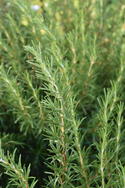
Scientific name: Rosmarinus officinalis
Common Name: Rosemary
Rosemary originates from Southern Europe.
Plant Description
The Rosemary plant is hardy and grows to about two meters in height. The plant is an evergreen shrub that has a grey scaly bark on the stem.
The plant has numerous side branches from which the numerous spiky linear leaves develop. The leaves are dark green on top with a lighter underside. The flowers that form on the tips of the branches are a delicate blue.
Uses
Rosemary in both its fresh form and dried is used in many food dishes as a flavouring. The other use is for the production of essential oils. The flowers have the highest quality oils and yield a fresh and more delicate camphor aroma. The rest of the plant also yields oils but has a stronger camphor aroma.Soil Requirements and Preparation
Rosemary does best in a well-drained sandy loam soil with a pH of between 6 and 7.5. Do not plant in soils high in clay. In heavier soils, it is best to ridge the plant rows to aid with the drainage of water away from the roots.
Before any soil preparation is done a representative soil sample should be taken and sent to a laboratory for analysis and nutrient recommendations. Soils should be ripped to loosen the soil profile to about 600 mm. Lime, for pH rectifying, manure or compost should be applied and ploughed into the top 400 mm of soil about four to five weeks before planting.
In the final days before planting add trace elements and a balanced pre-plant fertilizer to the soil and disc harrow into the top 20 cm of soil. This clears any weeds that may have established. If ridging is done then this is also done now and the seedbeds are now prepared for planting.
Climate
Rosemary is a hardy evergreen plant that grows in temperate climates and performs best in temperatures of between 18°C and 26°C. It is also tolerant of frost.Cultivars
There are three main types of rosemary produced commercially, Camphor-Borneol, Cineole and Verbenone.
Varieties available are, Albiflorus, Arp, Benendan Blue, Flora Rosa, Hill Hardy, Holly Hyde, Huntington Carpet, Irene, Majorca Pink, McConnell’s Blue and Tuscan Blue.
There are many other varieties and it is best to get the advice of the local extension officer and seed specialists for the best variety for your production area and for your target market.
By Louise Brodie